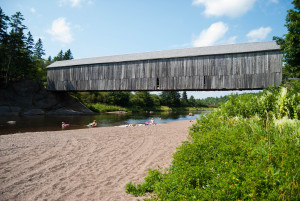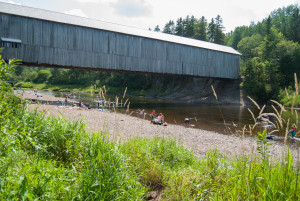Saltwater might run through the veins of many New Brunswickers, but fresh river arteries are the lifeblood of the tiny Canadian province. The St. John and Kennebecasis are the two most significant, but the many smaller tributaries are home to iconic covered bridges and spawning pools of the noble Atlantic salmon. The salmon have been in decline over the years, so most of the fishing you’ll encounter is catch and release. However, the age-old tradition of swimming in the deep, pristine pools and wading in the rocky shallows under the bridges, has been passed from generation to generation.
The Hammond River
The Hammond River is home to three covered bridges and dozens of salmon pools. It is one of the few remaining spawning areas in the world for the Atlantic salmon. Many of these pools are located directly beneath the bridges, making them ideal places for summer beaches, known mostly to the locals. You’re more apt to see children splashing in the deep holes than a salmon, but you’ll no doubt encounter the tiny fry nibbling at your toes or catch a glimpse of a school of parr or smolt through the crystal clear waters. Check out the life cycle of the Atlantic Salmon.
Long stretches of shallow rapids tumbling over boulders suddenly turn into deep, tranquil currents, often buffered by huge boulders and granite cliffs — the more adventurous climb as high as they can before leaping into the dark, cold depths. The river narrows and widens at will, often changing its course after long, cold winters. Many years can go by with only subtle changes, but one year of heavy ice pack that breaks up too quickly and you might not recognize your favourite swimming hole.
Smithtown Bridge
The Smithtown Covered Bridge and the salmon pool is a favourite local beach on the Hammond River. Year after year, families return with their children and grandchildren to play in the refreshing waters. The current can be dangerous early in the season or after heavy rain. However, once the dog days of summer arrive, water levels lower making for slow, lazy drifting on inner tubes or just lying on your back. The shallow shoreline is a perfect spot for younger children and those who just want to cool off, but there is plenty of deeper water for avid swimmers. The bridge is a perfect retreat from the hot sun or unexpected showers. The sandy, pebbled shore makes an ideal place for small bonfires in the evenings, with room for small tents for overnight adventures.
We like to bring snorkels and masks to do some exploring around the boulders in the deep pool. Outcroppings of granite submerged in the cool waters act as caves for brook trout, salmon, and smallmouth and striped bass. Binoculars are recommended for the great diversity of flora and fauna that make their home along the river’s edge. Ducks, shorebirds, and raptors are abundant. Turkey vultures circle in groups overhead searching for carrion. The majestic osprey and bald eagle are easy to spot, fishing and hunting for prey or feeding their young in their giant twig nests.
Explore The Hammond River By Kayak
Kayaking is a fantastic way to explore the covered bridges and salmon pools. Hammond River is 40 km (about 25 miles) long, so you have many options for launching. Depending on where you choose to put your kayak in, and the time of year, you may need to portage some of the river. I recommend putting in at Smithtown Bridge, then paddle your way under the French Village bridge. Continue past the Hammond River Angling Association Lodge in Nauwigewauk to the Darlings Island Bridge.
The river current slows dramatically by the lodge and flows through a substantial wetland before draining into Darlings Island Lake. You can continue on to the mouth of the river which flows into the Kennebacasis. Just a short drive from nearby Hampton or Saint John, the Hammond River is easily accessed by nearby Mackay Highway.
Additional Bridges In The Area
There are 60 covered bridges in New Brunswick, with 56 still in service. Sixteen of these are in Kings County making it the covered bridge capital of Atlantic Canada. Touring the covered bridges is a favourite pastime of locals and tourists alike. It’s always a favourite with photographers, so don’t be surprised to see wedding parties in and around any number of the bridges.
The Hammond River Angling Association has worked hard over the years to educate the public and landowners on best practices in order to ensure the river stays healthy. Water quality surveys along the river have been deemed excellent or good, with only four sites considered fair.



I like what you guys are up also. Such smart work and reporting!
Keep up the superb works guys I have incorporated you guys to my blogroll.
I think it will improve the value of my web site :
).